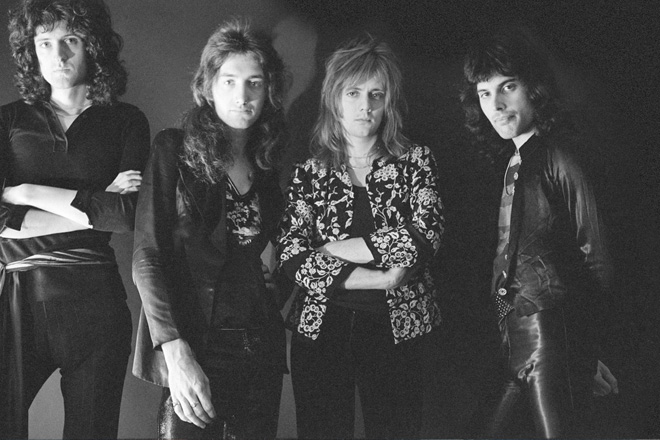
Brian May, John Deacon, Roger Taylor, Freddie Mercury
“Bohemian Rhapsody”
QUEEN
“Bohemian Rhapsody” is one of rock’s most beloved hits—and yet for all its brilliance, the song is only more remarkable considering it breaks every rule. There is no chorus. The form is odd and asymmetrical. The title never once appears in the lyric. It’s more than six minutes long. And it has an opera section with mock Italian lyrics.
That the disparate parts of the song add up to such a glorious sum is a testament to Freddie Mercury’s genius as a songwriter and arranger. “It was really Freddie’s baby from the beginning,” said guitarist Brian May. “He knew exactly what he wanted. The backing track was done with just piano, bass and drums with a few spaces for other things. Freddie had all his harmonies written out—it was really just a question of doing it.”
After lengthy rehearsals, the four-month recording sessions for the song’s parent album, A Night at the Opera, moved among six studios—a costly excess unheard of in 1975. Three weeks alone were spent on perfecting “Bohemian Rhapsody,” with seven days devoted to the operatic interlude. To achieve the “thunderbolt and lightning” grandeur, the group layered a whopping 160 tracks of vocal overdubs—no small feat in the days of 24-track analog recording. “We ran the tape through so many times it kept wearing out,” May said. “Once, we held the tape up to the light and we could see straight through it. The music had practically vanished.”
As the song was pieced together from various takes, Mercury remained confident that his vision would be realized. Producer Roy Thomas Baker wasn’t as sure. “Nobody really knew how it was going to sound as a whole six-minute song until it was put together. I recall standing at the back of the control room, and you just knew you were listening to a big page in history.”
Queen wanted to release it as the album’s first single—but both their manager and their label, EMI, deemed it too long for radio and suggested an edit. “We thought we’d better get some outside advice, so we took it to [influential DJ] Kenny Everett at Capital Radio,” Baker recalled. “He said, ‘I love this song. This is so good, they’ll have to invent a new chart position. Instead of it being No. 1, it’ll be No. 1/2” Everett aired the song 14 times over one October weekend—and by Monday morning, record stores were overrun with orders. EMI released it in its full-length glory. “We were adamant that it could be a hit in its entirety,” Mercury recalled. “We’ve been forced to make compromises, but cutting up a song will never be one of them.”
An accompanying video clip was also shot for “Bohemian Rhapsody,” presaging the MTV era by five years. In concert, the song proved to be a challenge. The band would leave the stage for the operatic section to allow recorded tracks to play before storming back on for the finale.
In November 1991, after Freddie Mercury’s death, “Bohemian Rhapsody” reappeared on the charts in the U.K. and achieved a rare distinction of going No. 1 twice. In the U.S., thanks to its appearance in the hit movie Wayne’s World, it also jumped back onto the charts.
Of his grandest achievement, Mercury once said, “‘Bohemian Rhapsody’ didn’t come out of thin air. I did a bit of research, although it was tongue-in-cheek and it was a mock opera. Why not? I certainly wasn’t saying I was an opera fanatic and I knew everything about it.”
–Bill DeMain



comment closed